President's Message
We didn't begin our 40th anniversary year very well. The first quarterly meeting scheduled for March 1 was cancelled because of an ice storm that was not supposed to happen. The prediction was that it was to warm up above freezing and turn to rain. However, it did not warm up until after our meeting was to begin.
The meeting was to include a state highway marker dedication and we had participants coming from long distances. One ramp on I-64 was closed, the Boulevard Bridge was closed and accidents were reported all over the region so we thought it best to reschedule the meeting for a later date.
The cancellation was reported on all three local stations. Inclement weather is often unpredictable and we have been very fortunate over the years to have most of our meetings as scheduled. I remember one March meeting held at Meadow Farm. It started snowing just as we had finished. Everyone fortunately made it home safely. Anna, the site manager, was very expectant with child, so when we saw the conditions, we called to see if we could drive her home. She thanked us and told us very pleasantly (which is her manner) she was from an area that had a lot of snow and was able to drive herself.
Because our June meeting had already been arranged, the War of 1812 Highway marker dedication has been rescheduled for September 13 at the same location as originally planned, Antioch Baptist Church. What an exciting opportunity we have for our June 7th meeting! We will meet at the Poe Museum. Curator Chris Semtner will introduce us to the Poe collection. Speaker Len Jolley from Essex, England will speak with us about his Henrico ancestor, John Cussons, followed by a tour of the former historic Henrico County Courthouse at 22nd and Main Street. The building is privately owned, and it is a unique opportunity to see where the government of Henrico County once operated.And that is not the only exciting news for our anniversary year. The Historical Society will be moving to Dabbs House, the official Visitors Center of Henrico County. Additional space there will allow us to further our efforts to promote the history of Henrico. We are all packed and ready to go. Later in the year, you will be invited to visit your new quarters.
Happy Anniversary, Henrico County Historical Society.
Sarah Pace,
President
>Back to Top<
Quarterly Meeting
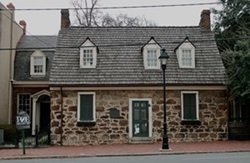
June at 1:30 on Sunday, June 7th, at the Poe Museum. The Poe Museum is located at 1914 E. Main Street in Richmond, VA 23233.
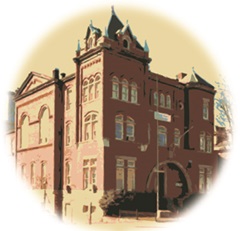
Then it is on to a tour of the historic Henrico County Courthouse at 22nd and Main Street.
Please call for registration: (804) 839-2407.
>Back to Top<
Edgar Allan Poe's Marriage
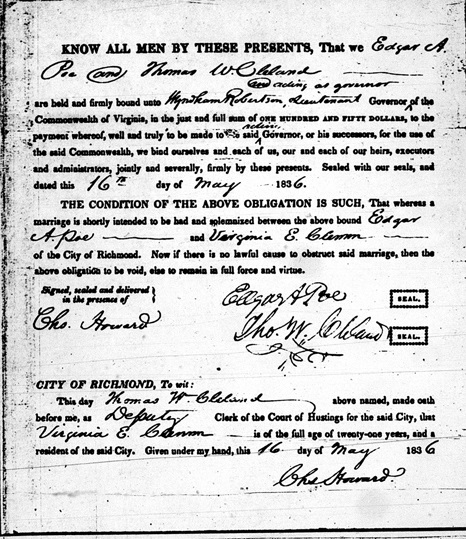
Since we will be meeting at the Poe Museum, we thought this item might be of interest.
In 1836, the twenty-seven-year-old Edgar Allan Poe married his thirteen-year-old first cousin, Virginia Clemm. It is interesting to note that the paragraph at the bottom of the document indicates that Thomas W. Cleland, who joined Poe in the bond, swore that Virginia was "of the full age of Twenty-one years." This image was taken from a microfilm file at the Library of Virginia. The original is filed in a drawer in a safe after it had been restored by the State Archives Department.
>Back to Top<
Cooking Up a Kitchen: A Taste of War
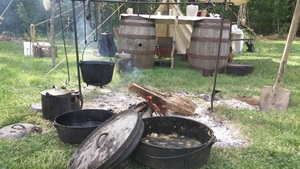
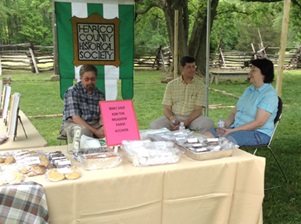
Open air cooking. A cast iron stew pot simmers over the fire, and a Dutch oven awaits its appointment with the coals.
Civil War cuisine was the order of the day at the War Between the Tastes sponsored by the APHA and held at Meadow Farm on Saturday May 9, 2015. Approximately 800 visitors attended, sampling wartime victuals including roasted corn, a surprisingly refreshing fruit and vinegar beverage and cobbler. Many also tried their hand at churning butter. The Henrico County Historical Society participated by holding a bakesale which netted $103 to aid in the project to recreate a historically accurate kitchen facility for the Meadow Farm site.
Treats. Rick Pace, Allan Wagner, and Debbie Shuck host the HCHS bakesale table at the May 9 Meadow Farm celebration of Civil War food.
>Back to Top<
Scenes from the Tea Dance at Walkerton
On Sunday, May 17, Henrico County Historical Society and the Colonial Dance Club of Richmond sponsored an afternoon of tea and dance to raise funds for the kitchen project at Meadow farm. Here are some of the people involved.
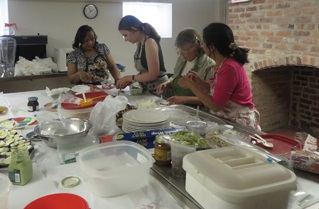
The food preparation crew.
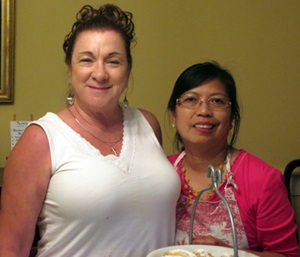
Diane Brownie and the chef, Lurline Wagner.
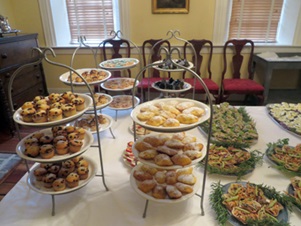
The gourmet treats.
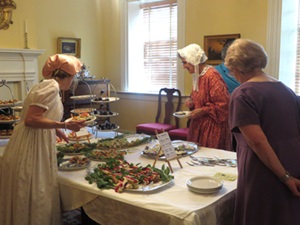
Participants sample the fare.
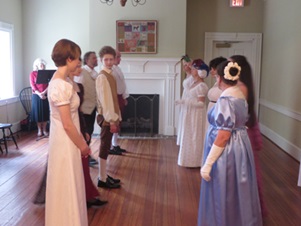
A group of dancers.
>Back to Top<
How a Local Government Gets Started Can Be Seen In Brookland's Beginnings
While Virginia is called the Mother of Presidents, she might also be called the mother of governing bodies, having been divided over and over at many different levels. Each of those divisions required the establishment of a governing body, and Henrico County has been "subdivided" time and time again, giving rise to nine other counties and part of a tenth since its establishment in 1634. So Henrico might deserve to be called midwife of the mother of governing bodies.
So how does a governing body arise and grow? What needs to be done first? Who is going to do what, and how is it all going to be paid for? Perhaps, a look at one of Henrico's magisterial districts might help us to understand.
In its modern form, the county has been divided into five magisterial districts. That all began with the 1870 Virginia Constitution, which required that each county in the state be divided into no less than three townships with each township electing administrative officials. A constitutional amendment in 1874 changed the townships into magisterial districts and each district elected one supervisor, three justices of the peace, one constable, and one overseer of the poor. The supervisors of the districts made up the county board of supervisors whose duties were identical to those set out in 1870.
Brookland Township was one of those original entities, and the Brookland Township Minutes from those early years provide us with an idea of just how communities go about establishing a governing structure and plan. The township began life on July 30, 1870, when Supervisor Dr. A. J. Ferrell, Assessor P. T. Atkinson, Road Commissioner C. G. Paleske and Township Clerk D. E. Gardner met at Mrs. Frances Bruns' store on the Brookland Turnpike and "proceeded to organize the Township Board." They needed a regular place to meet and they needed to record their actions; so the first order of business was to move that the room they were using be rented from Mrs. Bruns' at a Rental not to exceed Two Dollars a day for every day the Board may actually use the same." Of course, the Board needed material in which to keep records, so Gardner and Atkinson were "appointed a Committee to purchase the necessary Blank Books & Stationery and furniture for the use of the Board."
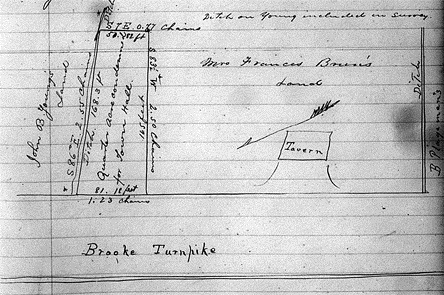
Brookland Town Hall site. This drawing from the Minutes of Brookland Township, 1870-1875 shows the layout of Frances Brun' land on which the Town Hall was built.
The officers next met on December 14, 1870, at "the Store House of Henry Neurohr on the Brook Turnpike." Apparently, area roads were a major priority, and the officers of this new division of the county then went to work to further divide this area and "lay off the Township into Four Road Districts." After identifying the borders and appointing an overseer for each of the four districts, it was on to taxes. The board ordered that "a Township tax of Seven Cents on every Hundred Dollars value of Real & Personal property be levied for the purpose of paying Township expenses for the current year ending the 30th day of June 1871." Additionally, the roads needed to be funded, so a ten-cent levy on real and personal property was ordered to meet road expenses. And a permanent place for meetings was needed, so the board ordered Atkinson and Gardner to investigate the possibility of procuring "the Brook Church Property."
That hope didn't work out; and on December 22, 1870, at the meeting at Henry Neurohr's tavern house, it was recommended that "a site be condemned on the lands of Mrs. Frances Bruns near Mr. Henry Neurohr's Tavern." And apparently this new board needed more money, so "It was ordered that a Tax of Four Cents on every Hundred Dollars value of Real and Personal Property be levied for Public Schools of the Township." The board also allowed an allotment of "Three Hundred Dollars for a Town Hall."
By January of 1871, a committee of "Wm. Y Mordecai, Wm. H. Sanders, L. H. Jeter, Alexander Hodgson and James T. Redd be . . . appointed a commission to view, condemn and assess the value of a lot of ground on the premises of Mrs. Frances Bruns, up on which there shall be erected a Town Hall."
In February, the board agreed to pay Mrs. Bruns fifty dollars for the land, and by the May 6, 1871 meeting, Wm. Y. Mordecai had become the Chairman. This meeting took place in the "New 'Township Hall,'" for which the board agreed to "pay to Mr. A. G. Ford Builder of the Township Hall Two Hundred and fifty Dollars in addition to the Three hundred already paid."
To make sure that the money was available, the tax collector needed to be paid; and it was decided that "seven and one half percentage be allowed the Township Collector as compensation on all collections." The burial of paupers needed to be seen to, and the board at the May meeting approved "Three Dollars for the burial of Henry Barnes a pauper." Similar entries for such services occur fairly regularly in ensuing meeting minutes– one even for payment of burial of Martha Moore, identified as a pauper suicide, and for payment for the inquest into her death.
Compared to budgets for Henrico County at large today, Brookland Township's accounting for collections and expenses for its first year pales. Of the $1,437.83 levied, the collector collected $1399.33, thereby earning $104.95. This left a total of $1,294.38, all of which was spent during that fiscal year - a balanced budget. In less than a year, the board had accomplished its basic priorities - officers, roads, taxes and a central facility. So, that seems to be how a government body gets started, and Brookland Township shows us the way.
by Joey Boehling
>Back to Top<
African American Education in 1880s Henrico
What is now the Carver area of the City of Richmond was originally a part of Henrico County, and in the third quarter of the 1800s, it was the site of a school for African American students–the Moore Street Industrial School.
In March 1875, members of the 2nd Baptist Church organized the Moore Street Missionary Baptist Church and purchased three buildings of an old soap factory in the area known as "Sheep Hill," so named because the route used to herd sheep bound for the slaughterhouse.
The deacons decided to establish a school and had a large portion of the church property deeded to the Moore Street Industrial School in 1880. John Oliver and Robert C. Hobson, who had been leaders during Reconstruction, were noted trustees of the school. By 1891, the school had sixty-two students and taught carpentry and printing to boys. Girls were instructed in the use of sewing machines to make clothing.
Transferring the deed from the church to the school caused the congregation trouble and resulted in a long suit that was finally settled in favor of the church in 1901. The Library of Virginia holds the Moore Street Missionary Baptist Church Minute Book and Ministers’ Aid Society Ledger, 1875-1882, and the minute book and ledger were used as evidence in the chancery case heard in the Circuit Court of Henrico County. Included in the ledger are two documents that offer an interesting peek into the financing and costs of educating young African Americans in the nineteenth century. It also illustrates the concern for the community and its youth held by many of its leaders.
The documents are a letter of May 11, 1888, to Mrs. A. J. Wynn (spelled "Winn" in the letter), a former teacher at the school, and her response. The letter reads as follows:
Mrs. Winn;
Kind Madam;
Knowing that you were at one time a teacher in charge of what is known at the Moore St. Industrial school, will you be kind enough to answer the following questions which will be of great benefit to the Moore St. B. Church in a suit which is now pending.
Yours truly,
J. P. Burrell
1st. Were you ever a teacher in the Moore St. Industrial school or any school on the property claimed by said institution. If so, by whom were you employed?
2. Was it a pay school or a free school. If pay school, please state amount paid by each scholar.
3. How long did you teach in said school.
4. From whom did you receive your pay? From the scholars alone, or from Mr. Oliver?
5. Can you state how many scholars usually attended your school.
N.B. After answering the above questions you will please sign your name and return this paper.
To the first question, Mrs. Wynn answered in the affirmative and identified Mr. John Oliver as her employer. She then indicated that the school was "Partially free" and added "25 cents monthly." She recalled that she had taught two terms of nine months each and part of another term in either January 1881 or February, but couldn't remember which. For this work, she was paid ten dollars a month from "Mr. John B. Crenshaw, treasurer of Moore St. Missionary Society, and 25 cts. from pupils." In answer to the final question she said that she had from 55 to 60 students and that "10 or 8 were poor children, unable to pay anything, and I was strictly charged never to turn such a one away." She added that "Fuel, crayons, maps were furnished by Mr. Oliver, when needed" and that she "always received the $10.00 promptly." She closed by noting that "A sewing school was in operation part of the time."
A teacher's recollection. The image below is a copy of Mrs. A.J. Wynn's responses to questions about her experience as a teacher at the Moore Street Industrial School. Library of Virginia
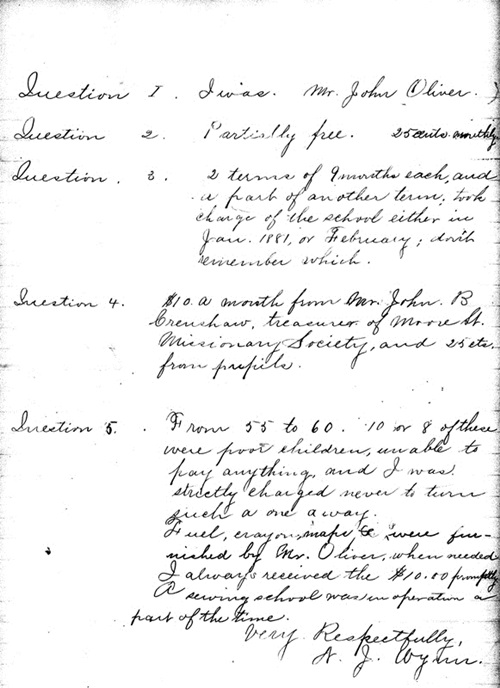
>Back to Top<
Sweet Drinks from a Sour Source
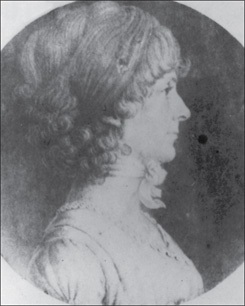
Mary Randolph's 1824 The Virginia Housewife was one of the first cookbooks written in America. It contained a wide array of recipes and concoctions, ranging from asparagus soup to a solution for cleaning knives and forks. The two vinegar-based beverages in the recipes below are seemingly similar to the drink served at Meadow Farm’s The War Between the Tastes. Why not give one a try?
Raspbery Vinegar
Put a quart of ripe red raspberries in a bowl; pour on them a quart of strong well flavoured vinegar--let them stand twenty-four hours, strain them through a bag, put this liquid on another quart, of fresh raspberries, which strain in the same manner--and then on a third quart: when this last is prepared, make it very sweet with pounded loaf sugar; refine and bottle it. It is a delicious beverage mixed with iced water.
Syrup of Vinegar
Put a quart of ripe red raspberries in a bowl; pour on them a quart of strong well flavoured vinegar--let them stand twenty-four hours, strain them through a bag, put this liquid on another quart, of fresh raspberries, which strain in the same manner--and then on a third quart: when this last is prepared, make it very sweet with pounded loaf sugar; refine and bottle it. It is a delicious beverage mixed with iced water.
>Back to Top<
Now You Know: Building a Barn from 'Scratch'
We struck out again with our mystery object, eliciting no identifications or even guesses. The 32-inch hand-made wooden item pictured at the right is a barn scribe–a tool used for marking large timbers and planks in early barn building.
Early American barns were built according to the Scribe Rule where each timber was connected to its neighbor with a completely custom connection or joint. Scribing was the practice of pre-assembling all the timbers on the ground and creating reference marks to identify where each post and beam would be joined.
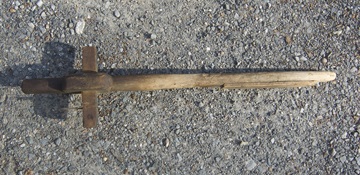
This scribe, pictured above, would be used to scratch marks on timbers to indicate where sawing should be done or where mortises should be chiseled. The distance from the timber’s edge to the necessary point for sawing or chiseling was measured. Then the square peg seen in the image below would be adjusted so that the small serrated blade (circled) would be at that distance. Then the builder would grasp the short and long handles, hold the flat part of the scribe against the timber and drag, leaving a groove to guide the chiseling or sawing.
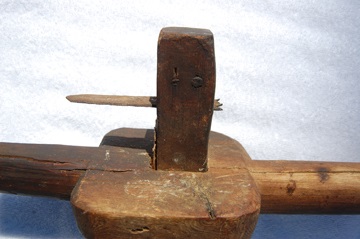
>Back to Top<
What Do You Know?
We've gone continental for this mystery object. It's French.
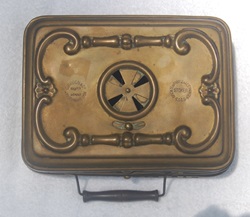
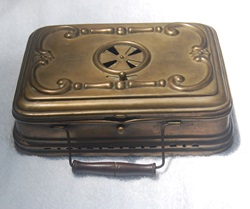
This relatively ornate 7.5" x 5.5" item is 2.5" deep, made of brass with small vent holes around the front of the base. It also has an adjustable, circular vent on the top. Inside is a 1.5" metal mesh "basket" that rests in a rack. The small circular insets are enlargements of the information embossed on the top.
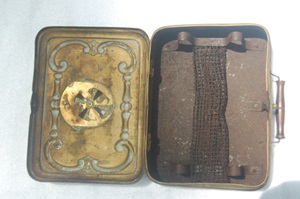
Do you know what it is?
Email your answers to
jboeling@verizon.net
>Back to Top<
News 2015: Second Quarter
First Quarter | Third Quarter | Fourth Quarter
Home | Henrico | Maps | Genealogy | Preservation | Membership | Shopping | HCHS
|











